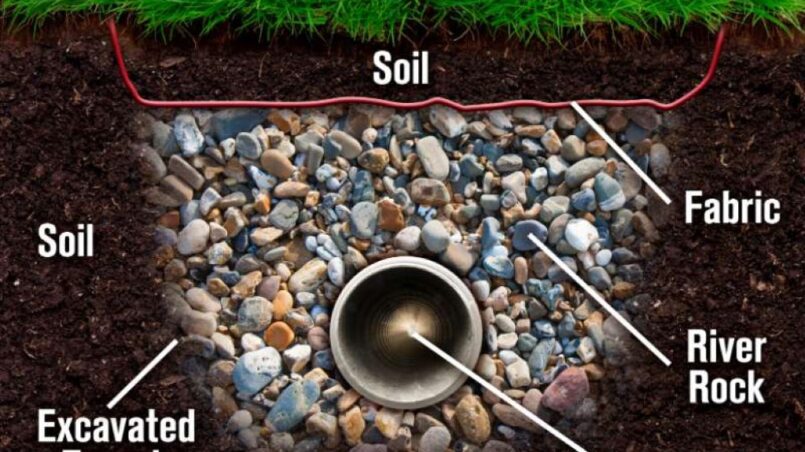Have you ever experienced the inconvenience of standing water in your yard or a damp basement after heavy rain? If so, you know how frustrating it can be. Excess water can cause damage to your property and affect its long-term stability. However, there’s a solution that can help you solve this problem: installing a French drain. But, what is a French ddrain? A French drain is a system that collects and redirects water away from your property, preventing it from causing damage. It involves digging a trench and lining it with gravel, then installing a perforated pipe that directs water to a designated drainage area. Not only does it effectively manage excess water, but it’s also a cost-effective and low-maintenance solution that can prevent future headaches.
What on Earth is a French Drain?
I know, it sounds fancy. But a French drain is actually a pretty simple and effective way to deal with wet areas around your home.
A French drain is basically a trench that is lined with gravel or rocks and has a perforated pipe running through the middle. The pipe has holes that allow water to flow in. As water enters the pipe, it is carried away from your home to another area of your yard. Et voila! No more soggy mess to deal with.
How’d They Get That Name?
The concept originated hundreds of years ago in good ol’ France. Clever French farmers devised the gravel-lined trenches to help drain water from their agricultural fields. I guess the name stuck even after the brilliant drainage system traveled across the pond.
Anatomy of French Drain
A French drain is a trench filled with gravel that collects and drains away water from the soil. It is a common solution for preventing water damage to foundations, basements, and landscaping. Anatomy of a French Drain:
- Perforated Pipe: The perforated pipe is the heart of the French drain system. It is a long, narrow pipe with holes that allow water to enter and flow through. The pipe is typically made of plastic or PVC and is about 4 inches in diameter.
- Gravel: Gravel is placed around the perforated pipe to help filter out dirt and debris. It also provides a space for water to collect and flow freely. The gravel should be about 1-2 inches in diameter.
- Filter Fabric: Filter fabric is optional, but it can help to prevent dirt and debris from clogging the gravel and perforated pipe. It is a thin, permeable fabric that is placed around the gravel before it is covered with dirt.
- Trench: The trench is the hole that the French drain system is installed in. The trench should be about 12 inches deep and wide. The slope of the trench should be about 1 inch per 10 feet to allow water to flow freely.
How it works?
- Water enters the French drain system through the perforated pipe.
- The water flows through the gravel and into the perforated pipe.
- The perforated pipe carries the water away from the foundation, basement, or landscaping.
- The water is eventually discharged into a storm drain or drainage ditch.
A Drain for Any Domain
French drains come in handy for all kinds of dilemmas in and around your home. Let’s talk about some of the most common spots a French drain works its magic.
Make a Basement Happy
Basement water accumulation is no joke. Not only can it cause mildew and mold, but it can also damage important stuff you may be storing down there. Luckily, a properly-installed French drain can draw that unwanted moisture away.
Dry Out the Yard
If parts of your yard turn into a marshy mess after storms, a French drain is on the rescue. Pop one of these bad boys in areas that don’t seem to soak up standing water well on their own. Your grass and garden will be much happier.
Guide Gutter Water Away
Does a river form off your roof after every rainfall? Adding a French drain by your foundation, connected to your downspouts keeps that deluge of gutter water from flooding your home. Pretty handy if you ask me!
Installing a Drain Ain’t No Thang
Okay, well it’s a little bit of a thang. But installing a French drain is totally DIY-friendly if you have the right tools and patience. Here’s what to do:
Pick Your Location
Figure out where the water accumulates and drain it from there. Use your noggin to determine where would make the most sense to direct the water flow.
Start Diggin’
Grab a shovel and dig a 1-2 foot deep trench in your chosen location. Make sure the trench slopes around 1 inch for every 8-10 feet. The slope helps the water flow swiftly through the drain.
Add Your Materials
Line the trench with gravel or crushed rocks first, then place the perforated piping. Wrap a filter fabric around the pipe to keep sediment out. Then fill in the rest of the trench with more gravel.
See Where It Flows
Extend one end of the drainage pipe to where you want the water to ultimately drain out – maybe your yard, a storm drain, etc. Help it continue to flow away with additional piping if needed.
And voila again! Your French drainage system is ready for action.
Over time, be sure to check on the drain to make sure nothing is blocking the flow of water. Flush debris out of the pipes with a pressure hose if needed.
Draining with Panache
While they aren’t beautiful landscaping elements, French drains are pretty life-changing for dealing with problematic moisture. I don’t know about you, but I’d take function over form any day when it comes to protecting my home!
Next time you find yourself with that sinking, waterlogged feeling, grab a shovel and trench your way to sweet, French drain success. Just mind your ankles around those open trenches, oui oui!
Frequently Asked Questions
What size pipe should I use?
You should use 4-6 inch diameter perforated PVC, ABS, or corrugated plastic pipe for most standard residential French drain applications.
How often do French drains need to be cleaned?
In most cases, you won’t need to actively clean out a French drain more than once every few years. Just use a garden hose to wash out debris that may accumulate over time.
Can I install a French drain myself?
Definitely! Installing a basic French drain is an achievable DIY project for a homeowner with good physical ability and basic construction skills. You’ll need things like shovels, gravel, perforated pipe, filter fabric, etc. Just be sure to call 811 before any digging.
Where should the water drain to?
Ideally your French drain will empty into a lower elevation like your yard, a storm sewer, street gutter, or natural hillside. This allows gravity to keep pulling the water away without any backups.
How much does a French drain system cost?
It depends on the size and complexity, but most homeowners spend $2,000 – $5,000 to install an exterior perimeter French drain. Cost factors include labor/equipment rental, materials, permits if needed, and any landscaping to conceal the drain.
Last Words
Dealing with wet basements, saturated yards, and flooded landscaping is no fun. But French drains offer a practical, efficient solution to whisk that pesky water away. With drainage trenches that divert water and debris through gravel beds and perforated piping, French drains channel moisture from problem spots around your property.
Installing these handy drains is quite doable as a DIY home project if you have enough space to dig and sloping terrain for gravity drainage. All about drain lining: much like calculating trench slope and drainage plans to prevent a soggy situation for French farmers, understanding the intricacies of drain lining is essential for maintaining proper drainage and ensuring happy homeowners. Voila, a well-lined drain makes for a worry-free property!
















